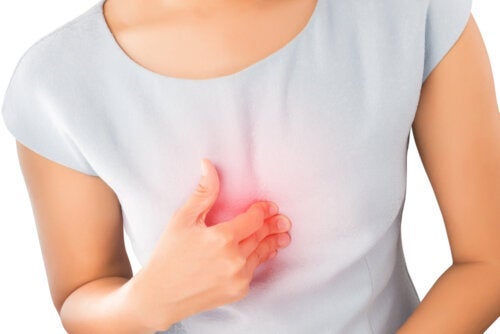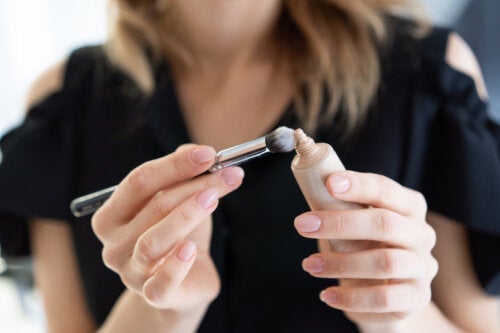Let op signalen van een hoog cortisolpeil in je lichaam

Hydrocortisone of cortisol is een hormoon dat in de bijnieren geproduceerd wordt. Een hoog cortisolpeil kan je gezondheid aantasten.
Want cortisol heeft de functie om de bloedsuikerspiegel te laten stijgen. Maar het kan echter ook de botvorming verminderen en aandoeningen zoals obesitas veroorzaken.
Wanneer je cortisolpeil hoog is, dan spreekt men van hypercortisolisme of het Cushingsyndroom. Deze aandoening veroorzaakt de ophoping van vet, een hoge bloeddruk en grote lichamelijke stress.
1. Plotselinge gewichtstoename
Gewichtstoename is één van de eerste symptomen van een hoog cortisolpeil.
Je merkt dit vooral in het bovenlijf. Want vet begint zich op te stapelen op de volgende plaatsen: de schouders, de borst en de rug.
Maar het meest vreemde aspect van dit fenomeen is dat de armen en de benen van deze persoon dun blijven.
2. Huidproblemen

Ook de huid wordt beïnvloed door hypercortisolisme.
Want het kan de ontwikkeling veroorzaken van:
- Acne
- Paarse letsels op de borsten, de buik en de dijen
- Kneuzingen
- Meer gezichts- en lichaamshaar
3. Musculoskeletale symptomen
Een hoog cortisolpeil kan ook een impact hebben op de spieren, pezen en de botten. De botstructuur wordt zwak. Het gevolg is dat het risico op breuken, vooral van de ribben en de ruggengraat, groter wordt.
4. Verstoringen in het immuunsysteem

De thymus is een klier die het menselijke immuunsysteem regelt. Ook dit orgaan zal aangetast raken als gevolg van een hoog cortisolpeil.
Een hoge cortisol kan het afsterven van cellen veroorzaken. Het gevolg is dat het immuunsysteem de lichaamsweefsels gaat aanvallen in plaats van het virus.
- De meest voorkomende symptomen van een falend immuunsysteem zijn astma en allergieën.
- Maar het probleem kan zelfs nog ernstiger worden. Want het kan lupus, de ziekte van Crohn of fibromyalgie veroorzaken.
5. Depressies en stemmingswisselingen
Angstgevoelens zijn één van de symptomen die meestal optreden wanneer iemand onder veel stress staat.
Dit gaat gepaard met voortdurende en plotse stemmingswisselingen gedurende de dag. In sommige gevallen zie je zelfs tekenen van ernstige depressie.
Sommige onderzoeken tonen aan dat een hoog cortisolpeil de bloeddoorstroming en de glucose-aanvoer van de hersenen laat dalen.
Dit zal het vermogen van onze hersencellen verstoren om glucose op te nemen. Sommige cellen kunnen dan afsterven.
6. Vermoeidheid en slapeloosheid

Cortisol verschaft energie. Maar dit kan averechts werken voor het lichaam.
Want in dit geval is het lichaam tijdens de dag extreem actief. Het lichaam rust dus niet. ‘s Nachts kan de persoon zich niet ontspannen door het teveel aan hormonen. Die mensen zullen het dus moeilijk hebben om te slapen.
- In normale omstandigheden stijgt het cortisolpeil in het lichaam rond acht uur ‘s morgens. Dit is om energie te verschaffen.
- Maar in het geval van hypercortisolisme is de situatie omgekeerd. Want het hormoon is ‘s nachts actief en ‘s morgens uitgeput.
Hoe kan je een hoog cortisolpeil in het lichaam laten dalen?
We geven je hier enkele tips hoe je het cortisolpeil in het lichaam kan laten dalen. Het zal je helpen om een gezonder leven te leiden.
Zeg koffie vaarwel
Cafeïne heeft de neiging om het cortisolpeil in het bloed binnen het uur met minstens dertig procent te laten stijgen. Maar in sommige gevallen kunnen de effecten zelfs achttien uren duren.
Is het jouw bedoeling om je katabole metabolisme te verlagen en je anabole metabolisme te verhogen? Drink dan geen koffie meer.
Probeer meer te slapen

Verbeter je slaapcyclus. Je kan dit doen door vóór je gaat slapen kamille- of valeriaanthee te drinken. Dit zal ervoor zorgen dat je lichaam sneller inslaapt en langer slaapt.
Het gevolg is dat niet alleen het cortisolpeil in je lichaam zal dalen. Je zal er ook jonger en gezonder uitzien. Bovendien zal het de invloed van veroudering verminderen.
Beweging
Het is bekend dat regelmatige lichaamsbeweging veel positieve effecten hebben. De spiermassa wordt vergroot en de productie van serotonine en dopamine stijgt. Dit zal het risico op de ontwikkeling van angstgevoelens of depressie verminderen.
Bovendien is dit niet het enige effect. Want je zal ook die overmatige energie verbranden die zich anders opstapelt in je lichaam. Je zal je cortisolpeil drastisch verlagen.
Zorg dat je bloedsuikerspiegel stabiel blijft
Eet daarnaast goede maaltijden die veel koolhydraten, eiwitten en vezels bevatten. Want dit helpt je om je bloedsuikerspiegel onder controle te houden.
Het wordt ook aanbevolen supplementen te nemen. Voorbeelden hiervan zijn vitamine B, calcium, magnesium, chromium, zink, vitamine C en alfa-liponzuur (ALA).
Hydrocortisone of cortisol is een hormoon dat in de bijnieren geproduceerd wordt. Een hoog cortisolpeil kan je gezondheid aantasten.
Want cortisol heeft de functie om de bloedsuikerspiegel te laten stijgen. Maar het kan echter ook de botvorming verminderen en aandoeningen zoals obesitas veroorzaken.
Wanneer je cortisolpeil hoog is, dan spreekt men van hypercortisolisme of het Cushingsyndroom. Deze aandoening veroorzaakt de ophoping van vet, een hoge bloeddruk en grote lichamelijke stress.
1. Plotselinge gewichtstoename
Gewichtstoename is één van de eerste symptomen van een hoog cortisolpeil.
Je merkt dit vooral in het bovenlijf. Want vet begint zich op te stapelen op de volgende plaatsen: de schouders, de borst en de rug.
Maar het meest vreemde aspect van dit fenomeen is dat de armen en de benen van deze persoon dun blijven.
2. Huidproblemen

Ook de huid wordt beïnvloed door hypercortisolisme.
Want het kan de ontwikkeling veroorzaken van:
- Acne
- Paarse letsels op de borsten, de buik en de dijen
- Kneuzingen
- Meer gezichts- en lichaamshaar
3. Musculoskeletale symptomen
Een hoog cortisolpeil kan ook een impact hebben op de spieren, pezen en de botten. De botstructuur wordt zwak. Het gevolg is dat het risico op breuken, vooral van de ribben en de ruggengraat, groter wordt.
4. Verstoringen in het immuunsysteem

De thymus is een klier die het menselijke immuunsysteem regelt. Ook dit orgaan zal aangetast raken als gevolg van een hoog cortisolpeil.
Een hoge cortisol kan het afsterven van cellen veroorzaken. Het gevolg is dat het immuunsysteem de lichaamsweefsels gaat aanvallen in plaats van het virus.
- De meest voorkomende symptomen van een falend immuunsysteem zijn astma en allergieën.
- Maar het probleem kan zelfs nog ernstiger worden. Want het kan lupus, de ziekte van Crohn of fibromyalgie veroorzaken.
5. Depressies en stemmingswisselingen
Angstgevoelens zijn één van de symptomen die meestal optreden wanneer iemand onder veel stress staat.
Dit gaat gepaard met voortdurende en plotse stemmingswisselingen gedurende de dag. In sommige gevallen zie je zelfs tekenen van ernstige depressie.
Sommige onderzoeken tonen aan dat een hoog cortisolpeil de bloeddoorstroming en de glucose-aanvoer van de hersenen laat dalen.
Dit zal het vermogen van onze hersencellen verstoren om glucose op te nemen. Sommige cellen kunnen dan afsterven.
6. Vermoeidheid en slapeloosheid

Cortisol verschaft energie. Maar dit kan averechts werken voor het lichaam.
Want in dit geval is het lichaam tijdens de dag extreem actief. Het lichaam rust dus niet. ‘s Nachts kan de persoon zich niet ontspannen door het teveel aan hormonen. Die mensen zullen het dus moeilijk hebben om te slapen.
- In normale omstandigheden stijgt het cortisolpeil in het lichaam rond acht uur ‘s morgens. Dit is om energie te verschaffen.
- Maar in het geval van hypercortisolisme is de situatie omgekeerd. Want het hormoon is ‘s nachts actief en ‘s morgens uitgeput.
Hoe kan je een hoog cortisolpeil in het lichaam laten dalen?
We geven je hier enkele tips hoe je het cortisolpeil in het lichaam kan laten dalen. Het zal je helpen om een gezonder leven te leiden.
Zeg koffie vaarwel
Cafeïne heeft de neiging om het cortisolpeil in het bloed binnen het uur met minstens dertig procent te laten stijgen. Maar in sommige gevallen kunnen de effecten zelfs achttien uren duren.
Is het jouw bedoeling om je katabole metabolisme te verlagen en je anabole metabolisme te verhogen? Drink dan geen koffie meer.
Probeer meer te slapen

Verbeter je slaapcyclus. Je kan dit doen door vóór je gaat slapen kamille- of valeriaanthee te drinken. Dit zal ervoor zorgen dat je lichaam sneller inslaapt en langer slaapt.
Het gevolg is dat niet alleen het cortisolpeil in je lichaam zal dalen. Je zal er ook jonger en gezonder uitzien. Bovendien zal het de invloed van veroudering verminderen.
Beweging
Het is bekend dat regelmatige lichaamsbeweging veel positieve effecten hebben. De spiermassa wordt vergroot en de productie van serotonine en dopamine stijgt. Dit zal het risico op de ontwikkeling van angstgevoelens of depressie verminderen.
Bovendien is dit niet het enige effect. Want je zal ook die overmatige energie verbranden die zich anders opstapelt in je lichaam. Je zal je cortisolpeil drastisch verlagen.
Zorg dat je bloedsuikerspiegel stabiel blijft
Eet daarnaast goede maaltijden die veel koolhydraten, eiwitten en vezels bevatten. Want dit helpt je om je bloedsuikerspiegel onder controle te houden.
Het wordt ook aanbevolen supplementen te nemen. Voorbeelden hiervan zijn vitamine B, calcium, magnesium, chromium, zink, vitamine C en alfa-liponzuur (ALA).
Alle aangehaalde bronnen zijn grondig gecontroleerd door ons team om hun kwaliteit, betrouwbaarheid, actualiteit en geldigheid te waarborgen. De bibliografie van dit artikel werd beschouwd als betrouwbaar en wetenschappelijk nauwkeurig.
- Amasi-Hartoonian, N., Sforzini, L., Cattaneo, A., & Pariante, C. M. (2022). Cause or consequence? Understanding the role of cortisol in the increased inflammation observed in depression. Current Opinion in Endocrine and Metabolic Research, 24, 100356. https://www.ncbi.nlm.nih.gov/pmc/articles/PMC7612780/
- Çay, M. (2017). The Effect of Cortisol Level Increasing Due to Stress in Healthy Young Individuals on Dynamic and Static Balance Scores. Northern Clinics of Istanbul. https://pubmed.ncbi.nlm.nih.gov/30859159/
- Chen, Y., & Lyga, J. (2014). Brain-Skin Connection: Stress, Inflammation and Skin Aging. Inflammation & Allergy-Drug Targets, 13(3), 177-190. https://www.ncbi.nlm.nih.gov/pmc/articles/PMC4082169/
- Chiodini, I., Scillitani, A. (2008). Role of cortisol hypersecretion in the pathogenesis of osteoporosis. Recenti Prog Med, 99(6), 309-13. https://pubmed.ncbi.nlm.nih.gov/18710063/
- Choe, S. J., Kim, D., Kim, E. J., Ahn, J. S., Choi, E. J., Son, E. D., Lee, T. R., & Choi, E. H. (2018). Psychological Stress Deteriorates Skin Barrier Function by Activating 11β-Hydroxysteroid Dehydrogenase 1 and the HPA Axis. Scientific Reports, 8(1). https://www.ncbi.nlm.nih.gov/pmc/articles/PMC5910426/
- Cuevas, G. S. (2016). La ansiedad y el estrés, nuestros peores enemigos. La Mente es Maravillosa. Consultado el 28 de septiembre de 2023. https://lamenteesmaravillosa.com/la-ansiedad-estres-peores-enemigos/
- Dziurkowska, E., & Wesolowski, M. (2021). Cortisol as a Biomarker of Mental Disorder Severity. Journal of Clinical Medicine, 10(21), 5204. https://www.ncbi.nlm.nih.gov/pmc/articles/PMC8584322/
- DiNicolantonio, J. J., Mehta, V., Onkaramurthy, N., & O’Keefe, J. H. (2018). Fructose-induced inflammation and increased cortisol: A new mechanism for how sugar induces visceral adiposity. Progress in Cardiovascular Diseases, 61(1), 3-9. https://pubmed.ncbi.nlm.nih.gov/29225114/
- Hackett, R. A., Dal, Z., & Steptoe, A. (2020). The relationship between sleep problems and cortisol in people with type 2 diabetes. Psychoneuroendocrinology, 117. https://www.ncbi.nlm.nih.gov/pmc/articles/PMC7302424/
- Haddad, C., Courand, P. Y., Berge, C., Harbaoui, B., & Lantelme, P. (2021). Impact of cortisol on blood pressure and hypertension-mediated organ damage in hypertensive patients. Journal of Hypertension, 39(7), 1412-1420. https://pubmed.ncbi.nlm.nih.gov/33534343/
- Hertel, J., König, J., Homuth, G., Van der Auwera, S., Wittfeld, K., Pietzner, M., Kacprowski, T., Pfeiffer, L., Kretschmer, A., Waldenberger, M., Kastenmüller, G., Artati, A., Suhre, K., Adamski, J., Langner, S., Völker, U., Völzke, H., Nauck, M., Friedrich, N., & Grabe, H. J. (2017). Evidence for Stress-like Alterations in the HPA-Axis in Women Taking Oral Contraceptives. Scientific Reports, 7(1). https://www.nature.com/articles/s41598-017-13927-7
- Hewagalamulage, S., Lee, T., Clarke, I., & Henry, B. (2016). Stress, cortisol, and obesity: a role for cortisol responsiveness in identifying individuals prone to obesity. Domestic Animal Endocrinology, 56, S112-S120. https://pubmed.ncbi.nlm.nih.gov/27345309/
- Kamba, A., Daimon, M., Murakami, H., Otaka, H., Matsuki, K., Sato, E., Tanabe, J., Takayasu, S., Matsuhashi, Y., Yanagimachi, M., Terui, K., Kageyama, K., Tokuda, I., Takahashi, I., & Nakaji, S. (2016). Association between Higher Serum Cortisol Levels and Decreased Insulin Secretion in a General Population. PLOS ONE, 11(11), e0166077. https://www.ncbi.nlm.nih.gov/pmc/articles/PMC5115704/
- Jones, C., & Gwenin, C. (2020). Cortisol level dysregulation and its prevalence—Is it nature’s alarm clock? Physiological Reports, 8(24). https://pubmed.ncbi.nlm.nih.gov/33340273/
- Lovallo, W. R., Whitsett, T. L., al’Absi, M., Sung, B. H., Vincent, A. S., & Wilson, M. F. (2005). Caffeine Stimulation of Cortisol Secretion Across the Waking Hours in Relation to Caffeine Intake Levels. Psychosomatic Medicine, 67(5), 734-739. https://www.ncbi.nlm.nih.gov/pmc/articles/PMC2257922/
- Lee, D. Y., Kim, E., & Choi, M. H. (2015). Technical and clinical aspects of cortisol as a biochemical marker of chronic stress. BMB Reports, 48(4), 209-216. https://www.ncbi.nlm.nih.gov/pmc/articles/PMC4436856/
- Paragliola, R. M., Corsello, A., Papi, G., Pontecorvi, A., & Corsello, S. M. (2021). Cushing’s Syndrome Effects on the Thyroid. International Journal of Molecular Sciences, 22(6), 3131. https://pubmed.ncbi.nlm.nih.gov/33808529/
- Peeters, G. M. E. E., van Schoor, N. M., van Rossum, E. F. C., Visser, M., & Lips, P. (2008). The relationship between cortisol, muscle mass and muscle strength in older persons and the role of genetic variations in the glucocorticoid receptor. Clinical Endocrinology, 69(4), 673-682. https://www.ncbi.nlm.nih.gov/pmc/articles/PMC7302424/
- Thau L, Gandhi J, Sharma S. Physiology, Cortisol. In: StatPearls [Internet]. Treasure Island (FL): StatPearls Publishing; 2022 Jan-. Available from: https://www.ncbi.nlm.nih.gov/books/NBK538239/
- Uwaifo GI, Hura DE. Hypercortisolism. [Updated 2022 Jul 4]. In: StatPearls [Internet]. Treasure Island (FL): StatPearls Publishing; 2022 Jan-. Available from: https://www.ncbi.nlm.nih.gov/books/NBK551526/
- Vargas, I., Vgontzas, A. N., Abelson, J. L., Faghih, R. T., Morales, K. H., & Perlis, M. L. (2018). Altered ultradian cortisol rhythmicity as a potential neurobiologic substrate for chronic insomnia. Sleep Medicine Reviews, 41, 234-243. https://pubmed.ncbi.nlm.nih.gov/29678398/
- Walter, K. N., Corwin, E. J., Ulbrecht, J., Demers, L. M., Bennett, J. M., Whetzel, C. A., & Klein, L. C. (2012). Elevated thyroid stimulating hormone is associated with elevated cortisol in healthy young men and women. Thyroid research, 5(1), 1-6. https://link.springer.com/article/10.1186/1756-6614-5-13
- Woldeamanuel, Y. W., Sanjanwala, B. M., & Cowan, R. P. (2020). Endogenous glucocorticoids may serve as biomarkers for migraine chronification. Therapeutic Advances in Chronic Disease, 11, 204062232093979. https://www.ncbi.nlm.nih.gov/pmc/articles/PMC7495027/
Deze tekst wordt alleen voor informatieve doeleinden aangeboden en vervangt niet het consult bij een professional. Bij twijfel, raadpleeg uw specialist.







